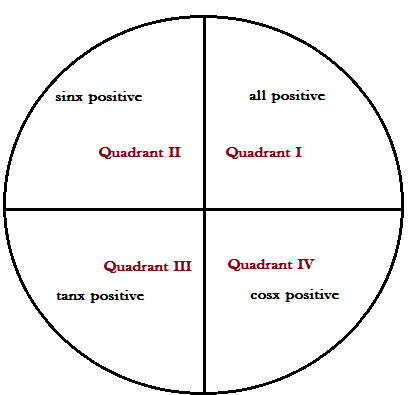
Find the value of $\cot \left( { - \dfrac{{15\pi }}{4}} \right)$
Answer
575.4k+ views
Hint: Note that, \[{\text{cot}}( - x) = - \cot x\]
Again, we know that the function y= cotx has a period of\[\pi \] or \[180^\circ .\], i.e. the value of cotx repeats after an interval of \[\pi \]or 180°.
Therefore write $\dfrac{{15\pi }}{4}$ as \[4\pi - \dfrac{\pi }{4}\] and proceed.
Complete step-by-step answer:
We know that the function y= cotx has a period of \[\pi \] or \[180^\circ .\], i.e. the value of cotx repeats after an interval of \[\pi \] or \[180^\circ .\].
Therefore,
\[\cot \left( { - \dfrac{{15\pi }}{4}} \right)\]
Since, \[{\text{cot}}( - x) = - \cot x\],
\[ = - \cot \left( {\dfrac{{15\pi }}{4}} \right)\]
On expanding the numerator we get,
\[ = - \cot \left( {\dfrac{{16\pi - \pi }}{4}} \right)\]
On simplification we get,
\[ = - \cot \left( {4\pi - \dfrac{\pi }{4}} \right)\]
Since, \[\left( {\dfrac{{15\pi }}{4}} \right){\text{ }}\] lies in the fourth quadrant, therefore \[\cot \left( {\dfrac{{15\pi }}{4}} \right){\text{ }}\] will be negative
\[ = - \left( { - \cot \dfrac{\pi }{3}} \right)\]
\[ = \cot \dfrac{\pi }{3}\]
As, \[\cot \dfrac{\pi }{3} = \dfrac{1}{{\sqrt 3 }}\]
\[ = \dfrac{1}{{\sqrt 3 }}\]
Therefore the value of $\cot \left( { - \dfrac{{15\pi }}{4}} \right)$is \[\dfrac{1}{{\sqrt 3 }}\].
Note: Note the following important formulae:
1.$\cos x = \dfrac{1}{{\sec x}}$ , $\sin x = \dfrac{1}{{\cos ecx}}$ , $\tan x = \dfrac{1}{{\cot x}}$
2.${\sin ^2}x + {\cos ^2}x = 1$
3.\[{\sec ^2}x - {\tan ^2}x = 1\]
4.\[{\operatorname{cosec} ^2}x - {\cot ^2}x = 1\]
5.$\sin ( - x) = - \sin x$
6.$\cos ( - x) = \cos x$
7.$\tan ( - x) = - \tan x$
8.$\sin \left( {2n\pi \pm x} \right) = \sin x{\text{ , period 2}}\pi {\text{ or 3}}{60^ \circ }$
9.$\cos \left( {2n\pi \pm x} \right) = \cos x{\text{ , period 2}}\pi {\text{ or 3}}{60^ \circ }$
10.$\tan \left( {n\pi \pm x} \right) = \tan x{\text{ , period }}\pi {\text{ or 18}}{0^ \circ }$
Sign convention:

Also, the trigonometric ratios of the standard angles are given by
Again, we know that the function y= cotx has a period of\[\pi \] or \[180^\circ .\], i.e. the value of cotx repeats after an interval of \[\pi \]or 180°.
Therefore write $\dfrac{{15\pi }}{4}$ as \[4\pi - \dfrac{\pi }{4}\] and proceed.
Complete step-by-step answer:
We know that the function y= cotx has a period of \[\pi \] or \[180^\circ .\], i.e. the value of cotx repeats after an interval of \[\pi \] or \[180^\circ .\].
Therefore,
\[\cot \left( { - \dfrac{{15\pi }}{4}} \right)\]
Since, \[{\text{cot}}( - x) = - \cot x\],
\[ = - \cot \left( {\dfrac{{15\pi }}{4}} \right)\]
On expanding the numerator we get,
\[ = - \cot \left( {\dfrac{{16\pi - \pi }}{4}} \right)\]
On simplification we get,
\[ = - \cot \left( {4\pi - \dfrac{\pi }{4}} \right)\]
Since, \[\left( {\dfrac{{15\pi }}{4}} \right){\text{ }}\] lies in the fourth quadrant, therefore \[\cot \left( {\dfrac{{15\pi }}{4}} \right){\text{ }}\] will be negative
\[ = - \left( { - \cot \dfrac{\pi }{3}} \right)\]
\[ = \cot \dfrac{\pi }{3}\]
As, \[\cot \dfrac{\pi }{3} = \dfrac{1}{{\sqrt 3 }}\]
\[ = \dfrac{1}{{\sqrt 3 }}\]
Therefore the value of $\cot \left( { - \dfrac{{15\pi }}{4}} \right)$is \[\dfrac{1}{{\sqrt 3 }}\].
Note: Note the following important formulae:
1.$\cos x = \dfrac{1}{{\sec x}}$ , $\sin x = \dfrac{1}{{\cos ecx}}$ , $\tan x = \dfrac{1}{{\cot x}}$
2.${\sin ^2}x + {\cos ^2}x = 1$
3.\[{\sec ^2}x - {\tan ^2}x = 1\]
4.\[{\operatorname{cosec} ^2}x - {\cot ^2}x = 1\]
5.$\sin ( - x) = - \sin x$
6.$\cos ( - x) = \cos x$
7.$\tan ( - x) = - \tan x$
8.$\sin \left( {2n\pi \pm x} \right) = \sin x{\text{ , period 2}}\pi {\text{ or 3}}{60^ \circ }$
9.$\cos \left( {2n\pi \pm x} \right) = \cos x{\text{ , period 2}}\pi {\text{ or 3}}{60^ \circ }$
10.$\tan \left( {n\pi \pm x} \right) = \tan x{\text{ , period }}\pi {\text{ or 18}}{0^ \circ }$
Sign convention:

Also, the trigonometric ratios of the standard angles are given by
| \[0^\circ \] | \[30^\circ \] | \[45^\circ \] | \[60^\circ \] | \[90^\circ \] | |
| \[\operatorname{Sin} x\] | 0 | $\dfrac{1}{2}$ | $\dfrac{1}{{\sqrt 2 }}$ | $\dfrac{{\sqrt 3 }}{2}$ | 1 |
| \[\operatorname{Cos} x\] | 1 | $\dfrac{{\sqrt 3 }}{2}$ | $\dfrac{1}{{\sqrt 2 }}$ | $\dfrac{1}{2}$ | 0 |
| \[\operatorname{Tan} x\] | 0 | $\dfrac{1}{{\sqrt 3 }}$ | 1 | $\sqrt 3 $ | Undefined |
| \[Cotx\] | undefined | $\sqrt 3 $ | 1 | $\dfrac{1}{{\sqrt 3 }}$ | 0 |
| \[\cos ecx\] | undefined | 2 | $\sqrt 2 $ | $\dfrac{2}{{\sqrt 3 }}$ | 1 |
| \[\operatorname{Sec} x\] | 1 | $\dfrac{2}{{\sqrt 3 }}$ | $\sqrt 2 $ | 2 | Undefined |
Recently Updated Pages
Master Class 12 Economics: Engaging Questions & Answers for Success

Master Class 12 Maths: Engaging Questions & Answers for Success

Master Class 12 Biology: Engaging Questions & Answers for Success

Master Class 12 Physics: Engaging Questions & Answers for Success

Master Class 8 Maths: Engaging Questions & Answers for Success

Class 8 Question and Answer - Your Ultimate Solutions Guide

Trending doubts
What is meant by exothermic and endothermic reactions class 11 chemistry CBSE

10 examples of friction in our daily life

One Metric ton is equal to kg A 10000 B 1000 C 100 class 11 physics CBSE

1 Quintal is equal to a 110 kg b 10 kg c 100kg d 1000 class 11 physics CBSE

Difference Between Prokaryotic Cells and Eukaryotic Cells

What are Quantum numbers Explain the quantum number class 11 chemistry CBSE




